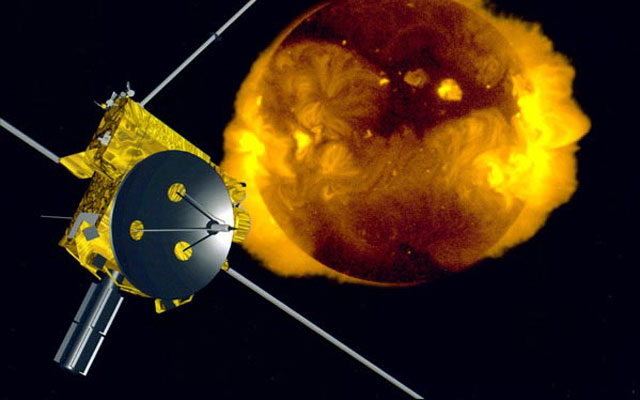
Earth and most of the other planets orbit the Sun on or close to the ecliptic, an imaginary plane like a flat tabletop. Although a number of spacecraft have examined the Sun from this perspective, it does not allow us to study the environment around the Sun's north and south poles. Exploring these regions is the aim of the Ulysses mission, a joint project between NASA and the European Space Agency.
The novel flight plan called for the Ulysses spacecraft to be carried into Earth orbit in the cargo bay of the Space Shuttle Discovery on October 6, 1990, after which it was propelled toward Jupiter by a combination of solid-fuel motors. Ulysses passed Jupiter on February 8, 1992; the giant planet's gravity bent the spacecraft's flight path downward and away from the ecliptic plane. This put it into a final orbit around the Sun that would take it past the Sun's north and south poles.
Ulysses made its first pass of the Sun's south pole in 1994, followed by a pass of the Sun's north pole in 1995. The next polar pass occurred in 2000. A third set of polar passes took place in 2006-7.
The prime mission concluded in 1995 but Ulysses continued to monitor the sun. The spacecraft, which operated for more than 18 years, ceased operations on June 30, 2009.
The spacecraft was built by Dornier Systems of Germany for the European Space Agency . NASA provided the launch via space shuttle and the upper stage boosters. The U.S. Department of Energy supplied a radioisotope thermoelectric generator which powers the spacecraft; other instruments were provided by both U.S. and European investigators. The spacecraft is operated from JPL by a joint team from the European Space Agency and NASA.
Mass: 370 kilograms (814 pounds)
Science instruments: Magnetometers, solar wind plasma experiment, solar-wind ion-composition spectrometer, energetic-particle composition experiment, low-energy charged-particle detector, cosmic ray and solar particle instrument, unified radio and plasma-wave experiment, solar-flare x-ray and cosmic gamma-ray burst experiment, cosmic dust experiment, coronal sounding experiment, gravity wave search